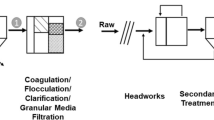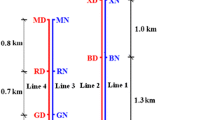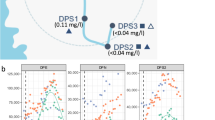Abstract
To understand the relationship between chemical and microbial treatment at each treatment step, as well as the relationship between microbial community structure in biofilms in biofilters and their ecological functions, a drinking water plant with severe organic matter-polluted source water was investigated. The bacterial community dynamics of two drinking water supply systems (traditional and advanced treatment processes) in this plant were studied from the source to the product water. Analysis by 454 pyrosequencing was conducted to characterize the bacterial diversity in each step of the treatment processes. The bacterial communities in these two treatment processes were highly diverse. Proteobacteria, which mainly consisted of beta-proteobacteria, was the dominant phylum. The two treatment processes used in the plant could effectively remove organic pollutants and microbial polution, especially the advanced treatment process. Significant differences in the detection of the major groups were observed in the product water samples in the treatment processes. The treatment processes, particularly the biological pretreatment and O3–biological activated carbon in the advanced treatment process, highly influenced the microbial community composition and the water quality. Some opportunistic pathogens were found in the water. Nitrogen-relative microorganisms found in the biofilm of filters may perform an important function on the microbial community composition and water quality improvement.




Similar content being viewed by others
References
Abbaszadegan M, Hasan MN, Gerba CP, Roessler PF, Wilson ER, Kuennen R, VanDellen E (1997) The disinfection efficacy of a point-of-use water treatment system against bacterial, viral and protozoan waterborne pathogens. Water Res 31:574–582
Chao A, Lee SM (1992) Estimating the number of classes via sample coverage. J Am Stat Assoc 417:210–217
Feazel LM, Baumgartner LK, Peterson KL, Frank DN, Harris JK, Pace NR (2009) Opportunistic pathogens enriched in showerhead biofilms. Proc Natl Acad Sci U S A 106:16393–16398
Hall-Stoodley L, Lappin-Scott H (1998) Biofilm formation by the rapidly growing mycobacterial species Mycobacterium fortuitum. FEMS Microbiol Lett 168:77–84
Holinger EP, Ross KA, Robertson CE, Stevens MJ, Harris JK, Pace NR (2014) Molecular analysis of point-of-use municipal drinking water microbiology. Water Res 49:225–235
Huang Y, Zou L, Zhang SY, Xie SG (2011) Comparison of bacterioplankton communities in three heavily polluted streams in China. Biomed Environ Sci 24:140–145
Kwon S, Moon E, Kim TS, Hong S, Park HD (2011) Pyrosequencing demonstrated complex microbial communities in a membrane filtration system for a drinking water treatment plant. Microbes Environ 26:149–155
Liao XB, Chen C, Chang CH, Wang Z, Zhang XJ, Xie SG (2012) Heterogeneity of microbial community structures inside the up-flow biological activated carbon (BAC) filters for the treatment of drinking water. Biotechnol Bioproc Eng 17:881–886
Liao XB, Chen C, Wang Z, Wan R, Chang CH, Zhang XJ, Xie SG (2013) Changes of biomass and bacterial communities in biological activated carbon filters for drinking water treatment. Process Biochem 48:312–316
Liao XB, Chen C, Zhang JX, Dai Y, Zhang XJ, Xie SG (2015) Operational performance, biomass and microbial community structure: impacts of backwashing on drinking water biofilter. Environ Sci Pollut Res 22:546–554
Liu RY, Yu ZS, Guo HG, Liu MM, Zhang HX, Yang M (2012a) Pyrosequencing analysis of eukaryotic and bacterial communities in faucet biofilms. Sci Total Environ 435:124–131
Liu RY, Yu ZS, Zhang HX, Yang M, Shi BY, Liu XC (2012b) Diversity of bacteria and mycobacteria in biofilms of two urban drinking water distribution systems. Can J Microbiol 58:261–270
Marciano-Cabral F, Jamerson M, Kaneshiro ES (2010) Free-living amoebae, Legionella and Mycobacterium in tap water supplied by a municipal drinking water utility in the USA. J Water Health 8:71–82
Matilainen A, Vepsalainen M, Sillanpaa M (2010) Natural organic matter removal by coagulation during drinking water treatment: a review. Adv Colloid Interf 159:189–197
Regan JM, Harrington GW, Noguera DR (2002) Ammonia- and nitrite-oxidizing bacterial communities in a pilot-scale chloraminated drinking water distribution system. Appl Environ Microbiol 68:73–81
Revetta RP, Gomez-Alvarez V, Gerke TL, Curioso C, Domingo JWS, Ashbolt NJ (2013) Establishment and early succession of bacterial communities in monochloramine-treated drinking water biofilms. FEMS Microbiol Ecol 86:404–414
Schloss PD, Westcott SL, Ryabin T, Hall JR, Hartmann M, Hollister EB, Lesniewski RA, Oakley BB, Parks DH, Robinson CJ, Sahl JW, Stres B, Thallinger GG, Van Horn DJ, Weber CF (2009) Introducing mothur: open-source, platform-independent, community-supported software for describing and comparing microbial communities. Appl Environ Microbiol 75:7537–7541
September SM, Brozel VS, Venter SN (2004) Diversity of nontuberculoid Mycobactetium species in biofilms of urban and semiurban drinking water distribution systems. Appl Environ Microbiol 70:7571–7573
Simpson DR (2008) Biofilm processes in biologically active carbon water purification. Water Res 42:2839–2848
Szewzyk U, Szewzyk R, Manz W, Schleifer KH (2000) Microbiological safety of drinking water. Annu Rev Microbiol 54:81–127
Vaerewijck MJM, Huys G, Palomino JC, Swings J, Portaels F (2005) Mycobacteria in drinking water distribution systems: ecology and significance for human health. FEMS Microbiol Rev 29:911–934
Velten S, Bolle M, Koster O, Helbing J, Weilenmann HU, Hammes F (2011) Development of biomass in a drinking water granular active carbon (GAC) filter. Water Res 45:6347–6354
Volk C, Bell K, Ibrahim E, Verges D, Amy G, Lechevallier M (2000) Impact of enhanced and optimized coagulation on removal of organic matter and its biodegradable fraction in drinking water. Water Res 34:3247–3257
Wang H, Pryor MA, Edwards MA, Falkinham JO, Pruden A (2013) Effect of GAC pre-treatment and disinfectant on microbial community structure and opportunistic pathogen occurrence. Water Res 47:5760–5772
Wu HT, Zhang JX, Mi ZL, Xie SG, Chen C, Zhang XJ (2015) Biofilm bacterial communities in urban drinking water distribution systems transporting waters with different purification strategies. Appl Microbiol Biotechnol 99(4):1947–1955
Xia XF, Zheng DD, Zhong HZ, Qin BC, Gurr GM, Vasseur L, Lin HL, Bai JL, He WY, You MS (2013) DNA sequencing reveals the midgut microbiota of Diamondback moth, Plutella xylostella (L.) and a possible relationship with insecticide resistance. PloS One 8:68852
Zhang Y, Love N, Edwards M (2009) Nitrification in drinking water systems. Crit Rev Environ Sci Tecchnol 39:153–208
Zwart G, Crump BC, Agterveld MPKV, Hagen F, Han SK (2002) Typical freshwater bacteria: an analysis of available 16S rRNA gene sequences from plankton of lakes and rivers. Aquat Microb Ecol 28:141–155
Acknowledgments
This work was supported by the Natural Science Foundation of China (Grant No. 31300109), Fujian Provincial Natural Science Foundation (Grant No. 2013 J05087), and Ningbo Municipal Natural Science Foundation (Grant No. 2014A610094).
Author information
Authors and Affiliations
Corresponding author
Additional information
Responsible editor: Gerald Thouand
Rights and permissions
About this article
Cite this article
Lin, H., Zhang, S., Zhang, S. et al. The function of advanced treatment process in a drinking water treatment plant with organic matter-polluted source water. Environ Sci Pollut Res 24, 8924–8932 (2017). https://doi.org/10.1007/s11356-015-5116-0
Received:
Accepted:
Published:
Issue Date:
DOI: https://doi.org/10.1007/s11356-015-5116-0




